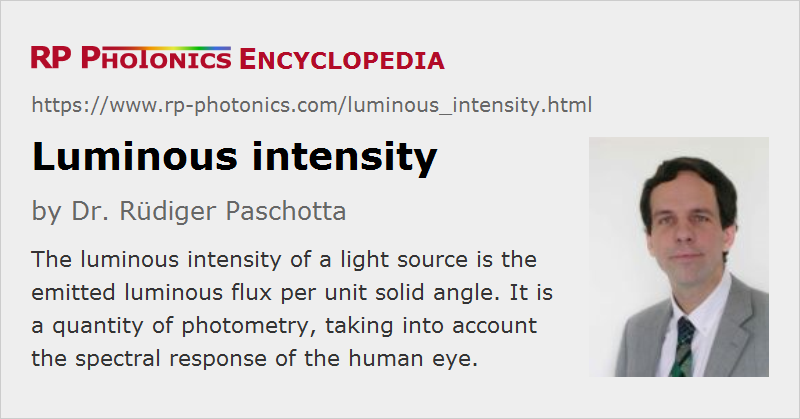Luminous Intensity
Definition: luminous flux per unit solid angle
German: Lichtstärke
Category: light detection and characterization
Formula symbol: Iv
Units: candela (cd = lm/sr)
How to cite the article; suggest additional literature
Author: Dr. Rüdiger Paschotta
The luminous intensity is a quantity for characterizing a light source. It is defined as the luminous flux per unit solid angle. The luminous intensity is a quantity of photometry, taking into account the spectral response of the human eye – typically for photopic vision, i.e., assuming sufficiently high light intensity (luminance) for color vision. The term is mostly applied with the approximation of a point source, i.e., in distances which are large to the extent of the source.
The analogous quantity in radiometry is the radiant intensity.
The SI units of the luminous intensity are the candela = lumen per steradian (cd = lm/sr). One candela approximately corresponds to the luminous intensity of a normal candle.
In the simplest case, where the luminous intensity is independent of the direction (uniform omnidirectional emission), the luminous intensity is the luminous flux divided by 4 π sr. If the light emission is restricted to a smaller solid angle, e.g. by a lamp housing containing a reflector, the luminous intensity can become correspondingly higher for the same luminous flux. On the other hand, the size of the emitting volume is irrelevant.
For uniform omnidirectional emission, the luminous intensity is independent of the distance from the light source – in contrast to the irradiance, which scales with the inverse square of the distance from the light source.
Questions and Comments from Users
Here you can submit questions and comments. As far as they get accepted by the author, they will appear above this paragraph together with the author’s answer. The author will decide on acceptance based on certain criteria. Essentially, the issue must be of sufficiently broad interest.
Please do not enter personal data here; we would otherwise delete it soon. (See also our privacy declaration.) If you wish to receive personal feedback or consultancy from the author, please contact him e.g. via e-mail.
By submitting the information, you give your consent to the potential publication of your inputs on our website according to our rules. (If you later retract your consent, we will delete those inputs.) As your inputs are first reviewed by the author, they may be published with some delay.
See also: photometry, luminous flux, radiant intensity
and other articles in the category light detection and characterization
 |




If you like this page, please share the link with your friends and colleagues, e.g. via social media:
These sharing buttons are implemented in a privacy-friendly way!